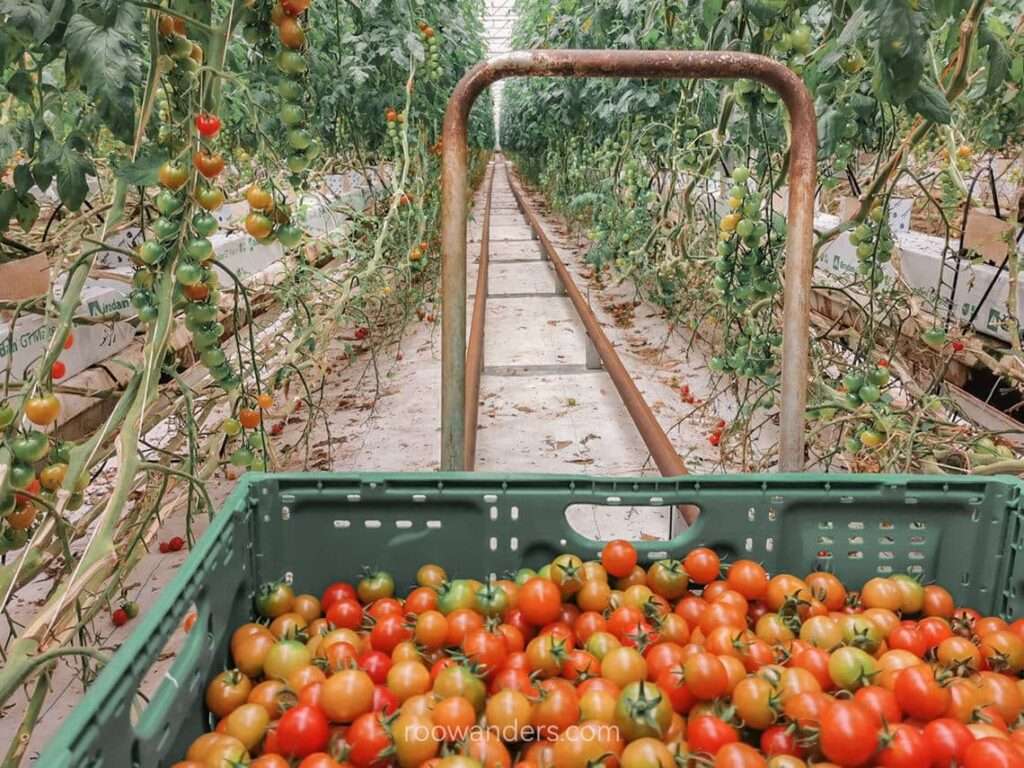
New Zealand Holiday Job #13: Tomato Greenhouse
The price of the ubiquitous tomatoes in New Zealand reminded me of the demand and supply graphs I studied in my Economics class back in my teens. You get low prices in the warmer months with a kilo of tomatoes selling at maybe two or three dollars per kilo, and the very high of 13 to 14 dollars per kilo in winter.
Why and how can the prices of tomatoes vary so much in a year?
After a short stint working as a picker-packer-grader of a tomato greenhouse in New Zealand, I can finally answer this question.
I worked in the greenhouse in Dec 2021. This post may be updated periodically.
Tomatoes Need Warmth
The tomato plant prefers warm and sunny conditions with lots of water, and the weather in NZ does not allow for that. They need more care and attention than the hardy carrots and lettuce or the temperate apples and cherries. As such, tomatoes – like bell peppers and eggplants – have to be grown in greenhouses.
Warmer months mean less energy to grow the crops. Energy consumption shoots up on dark, gloomy and cold days. Someone has to pay for that.
As we concluded our hops harvest and later apple thinning stint, we decided to stay put in Christchurch until my departure back to Singapore a month later. That was where we learnt about the tomato greenhouses around the suburbs and thought we’d give them a try.
Ps, we worked in the tomato greenhouse for only three days. Read on to find out why.

Greenhouses – Where?
Fresh tomatoes are grown all year round in New Zealand in glasshouses. I know a couple of glasshouses situated in the suburbs of Christchurch and Auckland and one big corporation based in Taupo. Since harvest is throughout the year and is generally unaffected by the changing seasons, these places are great for job seekers all year round. The peak seasons of other lucrative fruits – cherries, kiwi – may see workers leaving the greenhouses as working holidaymakers depart for other opportunities.
The greenhouse I worked at was around Lincoln town, about a 30 mins drive from Christchurch.
In The Greenhouse
The greenhouse I worked at had three units – two for tomatoes and a smaller central unit for eggplants. All three glasshouses connect to a warehouse where we do the packing.
There could be over 80 rows of tomato plants in each unit.
The tomato plant grows like vines, similar to the hop plants we tended in Tapawera. Both plants need to be staked and can climb to great heights.
But unlike the hops plants, which would eventually be axed and regrown after the harvest season, tomato plants do not. They grow in a confined glasshouse. The only way to let them grow without reaching the ceiling was to move their heads. Experienced staff rode on automated ladders and manually lengthened the string the plant grew on every once in a while. After weeks of growth, the plant could have its roots in aisle one but its head in aisle two or further, its body curved around each row.
The same technique applies to other greenhouse creepers like eggplants, capsicums and cucumbers.
These plants are grown in a soilless medium like pumice or sawdust, adopting hydroponics technology. Heating pipes lined up between the rows double up as tracks for us to push our picking carts.
There are nine cherry tomato varieties and a handful of plump tomatoes grown in the greenhouses.
To prevent the spread of diseases, we had to wash our hands and sterilise our shoes before entering any greenhouses.
Job Scope
Work starts at 7 am and usually ends around 4 pm. We have one long smoko around 10 am and a 30 mins unpaid lunch at 1 pm.
Monday and Thursday were picking days. On these days, we combed through rows of tomatoes and picked all the ripe or about-to-ripen tomatoes. During our stint in the glasshouse, I had the opportunity to pick cherry tomatoes but had to take almost two hours to comb through a long row meticulously. Any tomatoes with a tinge of red had to be plucked as they would be too ripe by the next picking day. Hot sun and high humidity double up their ripening pace.



Picking cherry tomatoes has its own set of rules as with picking cherries. We had to leave the stem intact. These would fetch high prices. Cherry tomatoes without stems are less desirable in the market.
Picking the generic big tomatoes seemed to be much simpler. The team combing through the big tomatoes completed their work earlier than us.
Tuesday and Friday were for packing. On these days, the team weighed and packed the cherry tomatoes into plastic boxes and stacked those boxes into plastic trays. The generic tomatoes were left in plastic trays. By the end of the day, half of the warehouse would be filled with plastic trays of tomatoes and eggplants, ready for the market.

Midweek is empty. And on empty hours, we pruned the plants. Pruning happened on Wednesday and after picking and packing.
As with picking, we rolled our trolleys of empty crates down a row and began to pull off the bottom six leaves of each plant. By the end of the row, the bottom rung – around my height – would be neat and ‘clean-shaven’ with unripened tomatoes visible for the next picking day.
The Good
Working in this greenhouse was pleasant. We could listen to our audio while working, which I happily took advantage of and loaded up all the podcast episodes I’d missed out on from previous days of not working.
The monotony also meant work was easy. We do not have to walk around or constantly carry heavy items. Picking beautiful tomatoes lifts moods too. Ripping apart leaves on pruning day mysteriously provides some relief as well.
At the end of packing days, there would be some ‘ugly’ tomatoes and eggplants left behind for us to take home for a small fee.
Our supervisor was a friendly man from Sri Lanka who could be nice to hang out with.



The Bad
Working in the greenhouse also meant a very humid and overly warm working environment. It may be nice during the winter when the weather is frigid and dry outside. But on summer days when we worked, I felt sluggish and uncomfortable.
Not everyone can work in greenhouses. Since the building is confined, you get an abundance of pollen hanging in the air. Overlooked and over-ripe tomatoes grow mould that releases spores and irritates the nose. They looked terrifying as well – half-melted and half-covered with whitish powder. My partner started developing reddish eyes and a runny nose by our second day of work, and we decided to call it quits on the third day.
Half an hour of driving to the suburbs early in the morning plus the traffic jam back into the city were tiring.
The greenhouse we worked in was 90% filled with workers of Chinese descent. The boss was also a Chinese man. The benefits were poor compared to all the other workplaces I’ve gone to. All new workers come in as casual staff, which effectively rules you from certain benefits like public holiday pay. Do not expect wages to go beyond the minimum rate while working in this greenhouse.

Ending
And that concludes my second last job and shortest stint in New Zealand! Despite the very short time, I still managed to go through all the critical roles – pick, pack and prune – and had the opportunity to experience and learn – kudos to the supervisor! – the workings behind greenhouse farming.








2 Comments
Jane
Hi! May I know the name of this tomato greenhouse you worked at?
Roo
Hey Jane, sorry, but I cannot remember the exact location or name. I believe there are greenhouses around the area of Springston Lincoln area.